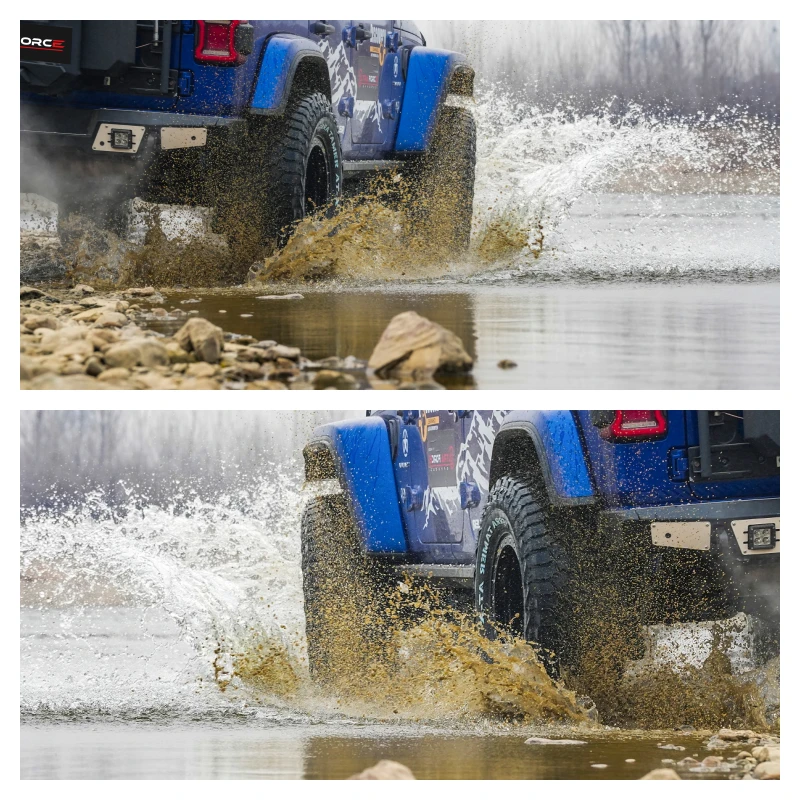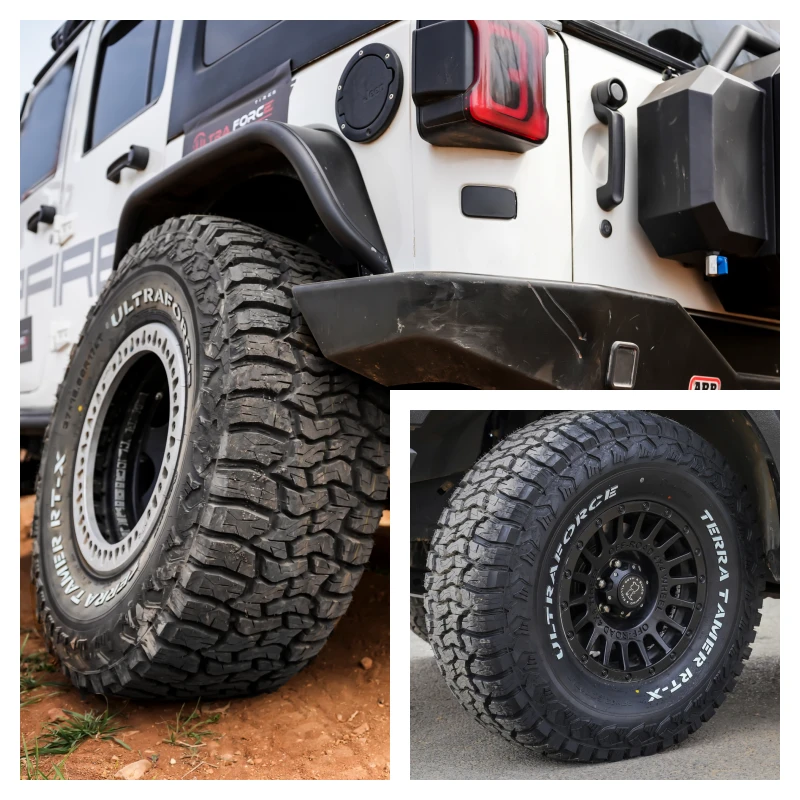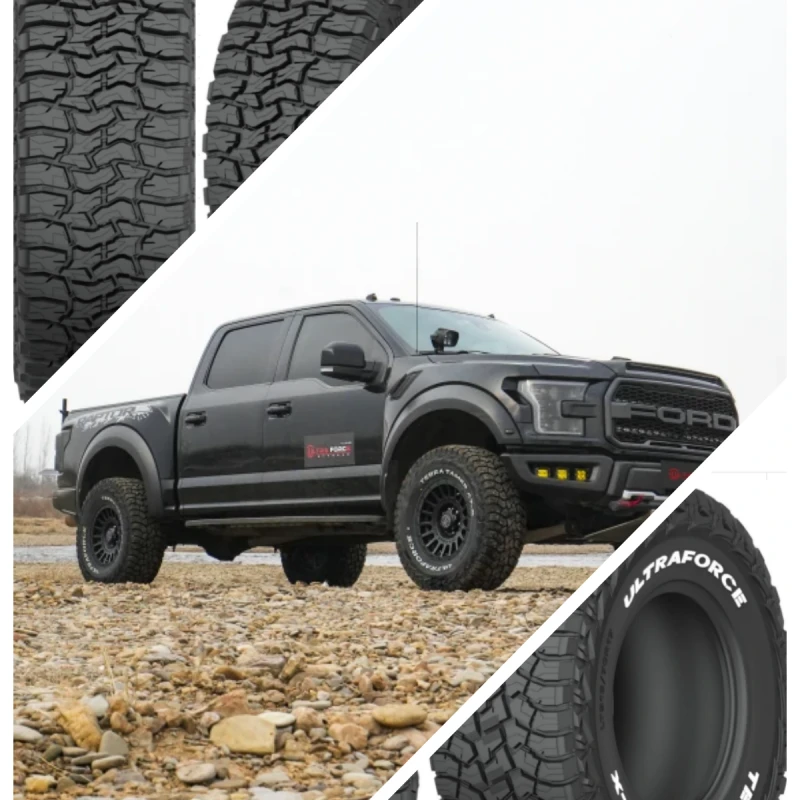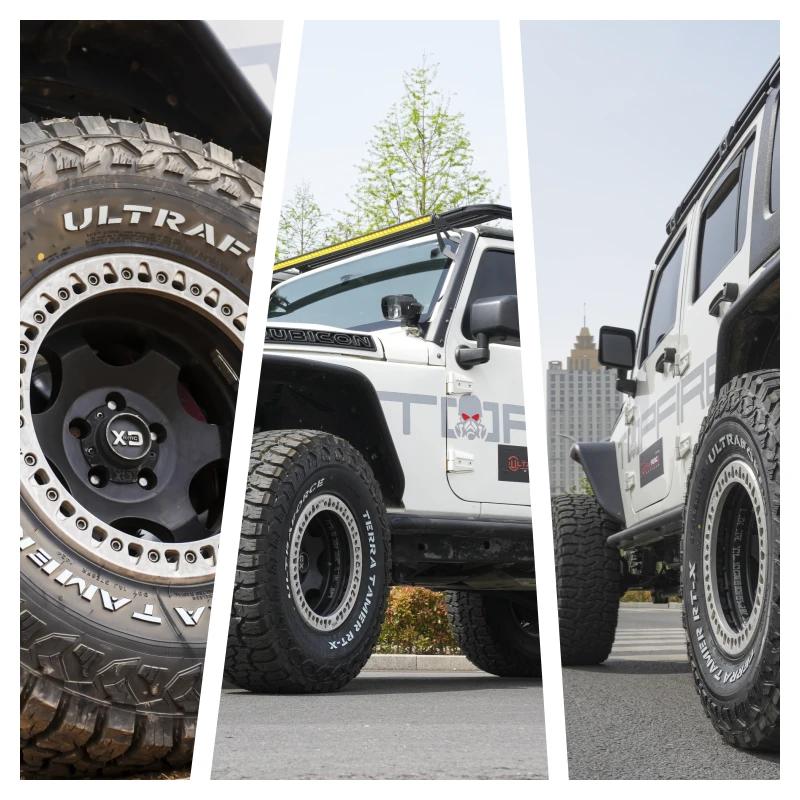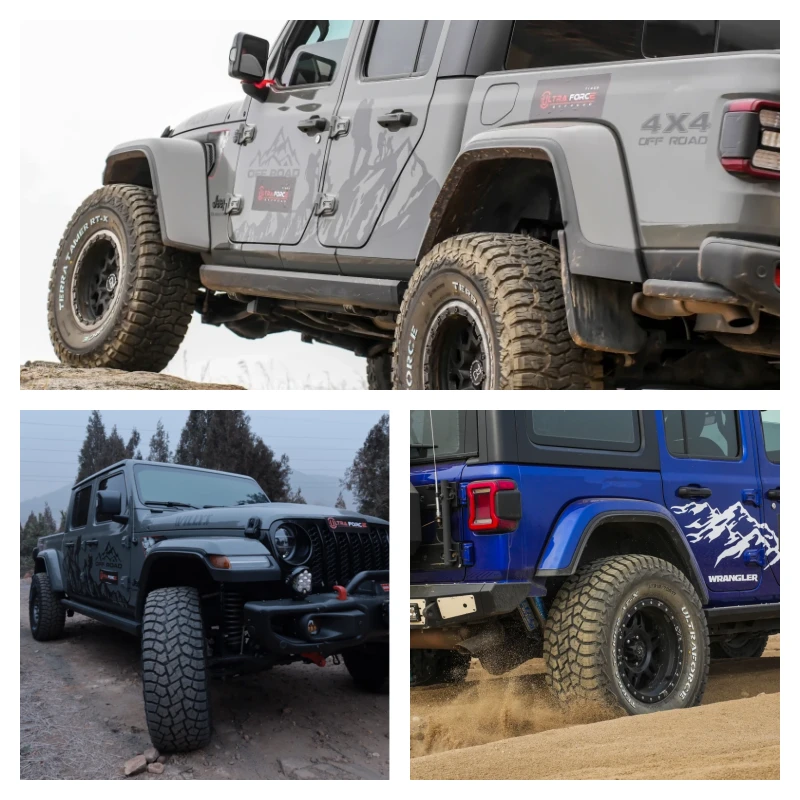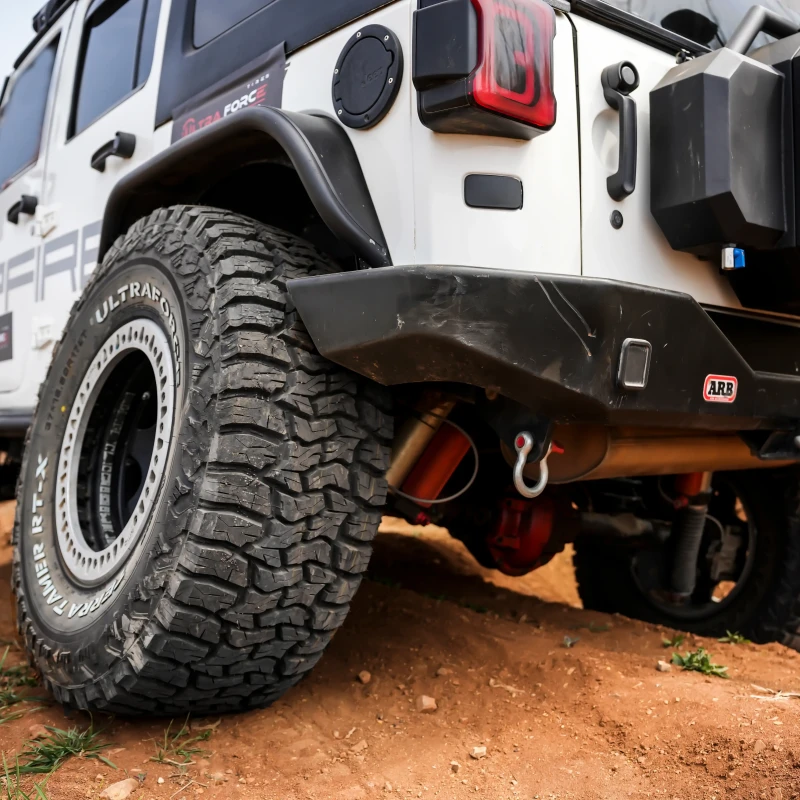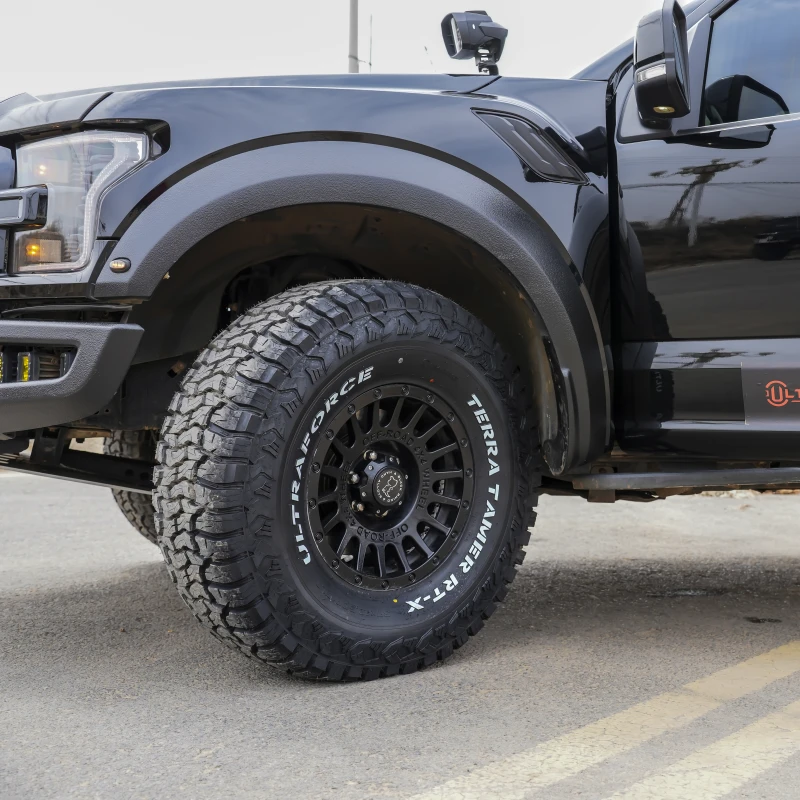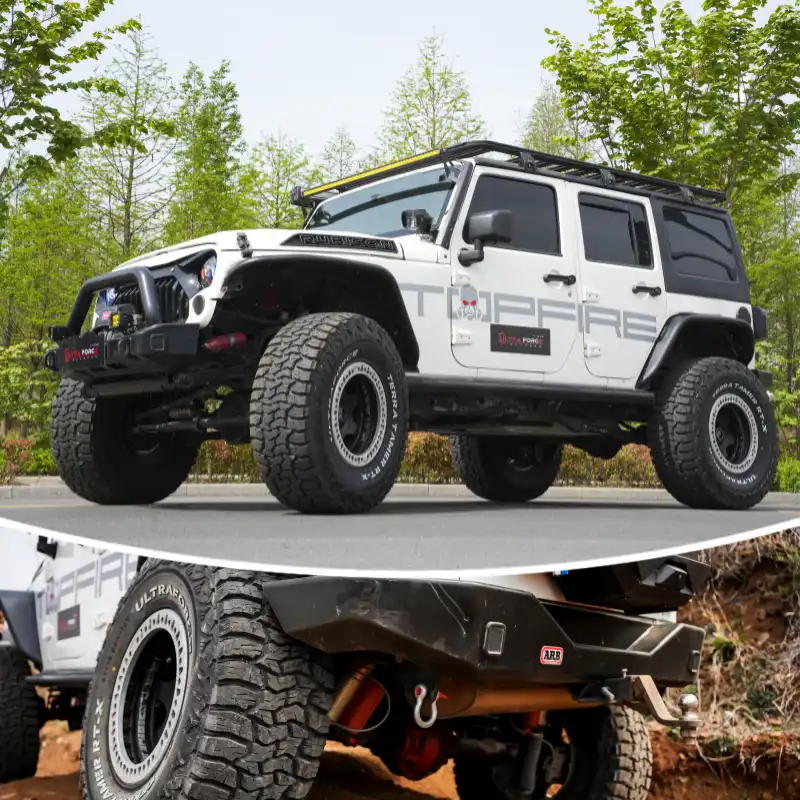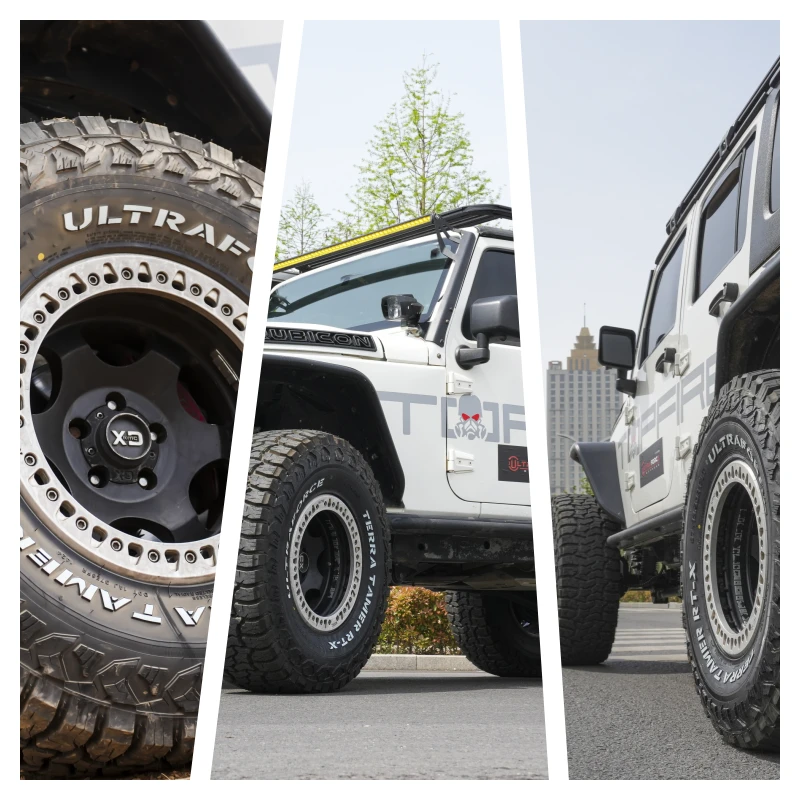Are Mud Terrain Tires Good on the Road?
Mud terrain tires are a popular choice among off-road enthusiasts, prized for their ruggedness, durability, and ability to tackle some of the toughest terrains. But how do they perform on regular paved roads? This article will delve into the pros and cons of using mud terrain tires on the road, exploring their performance, safety, and practicality for everyday driving. We’ll also introduce you to UltraForce Tires, a leader in the tire manufacturing industry, and how their products can meet your specific driving needs.
Understanding Mud Terrain Tires
Mud terrain tires are specifically designed for off-road use. Their aggressive tread patterns, with deep grooves and large, chunky lugs, are made to provide maximum traction in muddy, rocky, and uneven terrains. These tires are built with reinforced sidewalls and heavy-duty rubber compounds to withstand the rigors of off-roading, including sharp rocks, roots, and other obstacles.
However, when it comes to driving on paved roads, the characteristics that make mud terrain tires excel off-road can become disadvantages.
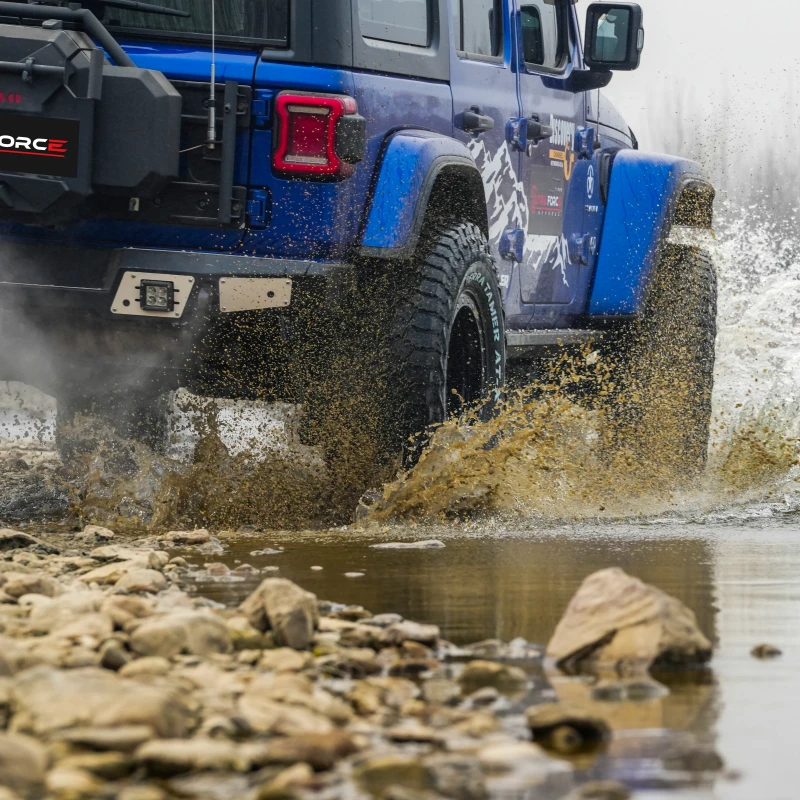
Performance on Paved Roads
Here’s a closer look at how mud terrain tires perform on regular roads:
1. Traction and Grip
Mud terrain tires are engineered to dig into soft, loose surfaces, which is why they feature large voids and wide tread blocks. On paved roads, these same features can reduce the tire’s contact patch with the road surface, leading to reduced traction, especially in wet conditions. The large voids in the tread can channel water effectively, but the reduced surface area in contact with the road can cause a lack of grip during sudden braking or sharp turns.
2. Ride Comfort and Noise
One of the most noticeable differences when driving with mud terrain tires on the road is the noise level. The aggressive tread design that works wonders off-road tends to produce a loud hum or roar when driving on smooth asphalt. Additionally, the stiff sidewalls and heavy construction can lead to a rougher ride, with less cushioning over bumps and potholes compared to all-terrain or highway tires.
3. Fuel Efficiency
Mud terrain tires are heavier and have more rolling resistance than their road-oriented counterparts. This increased rolling resistance means your vehicle’s engine has to work harder to maintain speed, which can lead to lower fuel efficiency. Drivers who switch to mud terrain tires for occasional off-roading might notice a drop in miles per gallon (MPG) during regular highway driving.
4. Tread Wear and Longevity
The robust construction of mud terrain tires, while excellent for durability off-road, can lead to uneven tread wear when used predominantly on paved roads. The softer rubber compounds and aggressive tread design can wear down more quickly on asphalt, leading to a shorter lifespan compared to tires designed specifically for highway use. The cost of replacing these tires more frequently can add up, making them a less economical choice for daily driving.
When Are Mud Terrain Tires a Good Choice for Road Use?
Despite the drawbacks, there are scenarios where mud terrain tires can be a viable option for road use:
1. Mixed-Use Driving
If your driving involves a combination of off-road adventures and daily commuting, mud terrain tires can be a reasonable compromise. Many drivers prefer the convenience of not having to switch tires when they hit the trails on weekends. In this case, you might choose to tolerate the noise, reduced comfort, and fuel efficiency in exchange for the superior off-road capability.
2. Severe Weather Conditions
Mud terrain tires can also be beneficial in regions with severe weather conditions. Their aggressive tread design can offer enhanced grip in deep snow or mud, making them useful for drivers in rural or mountainous areas where road conditions can be unpredictable. However, it’s important to note that their performance on ice and hard-packed snow might not match that of dedicated winter tires.
3. Heavy-Duty Vehicles
For heavy-duty trucks and SUVs that are frequently used for towing, hauling, or off-roading, mud terrain tires might be a practical choice. Their reinforced construction and load-bearing capacity can provide added stability and reliability when carrying heavy loads or navigating rough terrain.
Alternatives to Mud Terrain Tires for Road Use
If the drawbacks of mud terrain tires on the road outweigh the benefits for your specific driving needs, there are several alternatives to consider:
1. All-Terrain Tires
All-terrain (A/T) tires offer a balanced performance between off-road capability and on-road comfort. They feature a less aggressive tread pattern than mud terrain tires, providing better traction on paved roads while still handling light to moderate off-road conditions. All-terrain tires are ideal for drivers who want a versatile tire that can handle a variety of driving situations without compromising too much on comfort or fuel efficiency.
2. Highway Terrain Tires
Highway terrain (H/T) tires are specifically designed for on-road use, offering a smooth, quiet ride and excellent traction on paved surfaces. They have less aggressive tread patterns and are optimized for fuel efficiency and longevity. For drivers who spend most of their time on highways or city streets, H/T tires are a practical choice that delivers the best performance in typical road conditions.
3. Hybrid Terrain Tires
Hybrid terrain tires, also known as “rugged terrain” tires, are a newer category that bridges the gap between all-terrain and mud terrain tires. They offer a more aggressive tread than A/T tires but are quieter and more comfortable than traditional mud terrain tires. Hybrid terrain tires are suitable for drivers who want a tire that can handle tougher off-road conditions without sacrificing too much on-road comfort.
Choosing the Right Tire for Your Needs
Selecting the right tire depends on your specific driving needs, vehicle type, and the conditions you frequently encounter. While mud terrain tires offer unmatched performance in off-road scenarios, their on-road drawbacks make them less than ideal for drivers who spend most of their time on paved surfaces. However, if your lifestyle or work requires you to venture off-road frequently, mud terrain tires can be a valuable asset.
Fuel Efficiency of Mud-terrain Tires on Paved Roads
Mud terrain (MT) tires are designed for rugged off-road conditions, featuring aggressive tread patterns and reinforced sidewalls. While these features are advantageous off-road, they can impact fuel efficiency when driving on paved roads.
Understanding Fuel Efficiency and Rolling Resistance
Fuel efficiency in vehicles is largely influenced by rolling resistance—the frictional force resisting the motion when a tire rolls on a surface. Mud terrain tires have higher rolling resistance due to their large, chunky treads and robust construction. This higher rolling resistance means the engine has to work harder to maintain speed, leading to increased fuel consumption.
Data Insight: According to a study conducted by the U.S. Department of Energy, every 10% increase in rolling resistance results in a 1-2% decrease in fuel efficiency. Since mud terrain tires can have rolling resistance up to 20-30% higher than standard highway tires, drivers might see a fuel efficiency reduction of 2-6% when using MT tires on paved roads.
Case Study: Fuel Efficiency Comparison
Consider the case of a Toyota Tacoma owner who frequently drives both on highways and off-road trails. This owner switched from all-terrain (A/T) tires to mud terrain tires for better off-road performance.
Pre-Switch (All-Terrain Tires):
Average fuel efficiency: 18 MPG (miles per gallon)
Primary driving conditions: 70% highway, 30% off-road
Post-Switch (Mud Terrain Tires):
Average fuel efficiency: 16.8 MPG
Primary driving conditions: 70% highway, 30% off-road
Outcome: The switch to mud terrain tires resulted in a 7% decrease in fuel efficiency on the highway. For a driver covering 15,000 miles annually, this translates to an additional 66 gallons of fuel consumed per year, which can be a significant cost over time.
Mitigating Fuel Efficiency Loss
While mud terrain tires inherently reduce fuel efficiency on paved roads, drivers can take steps to mitigate this impact:
Proper Tire Inflation: Maintaining the correct tire pressure reduces rolling resistance. Under-inflated tires increase friction and fuel consumption.
Moderate Driving Habits: Avoiding aggressive acceleration and maintaining steady speeds can help reduce fuel consumption, even with MT tires.
Tire Rotation and Alignment: Regular tire rotation and ensuring proper wheel alignment can minimize uneven wear, reducing rolling resistance.
Data Insight: The U.S. Environmental Protection Agency (EPA) suggests that proper tire inflation can improve fuel efficiency by up to 3%, helping offset some of the losses associated with mud terrain tires.
In conclusion, while mud terrain tires are essential for off-road adventures, they do affect fuel efficiency on paved roads due to higher rolling resistance. However, with mindful driving practices and proper tire maintenance, the impact on fuel economy can be managed, allowing drivers to enjoy the benefits of MT tires without excessively compromising on fuel costs.
Are Mud Terrain Tires Safe for Winter Driving?
Mud terrain tires are designed to handle extreme off-road conditions, but their performance on icy or snowy roads during winter is a common concern. Understanding how these tires perform in winter conditions is crucial for safety.
Mud Terrain Tires vs. Winter Tires
Winter tires are specifically engineered for cold temperatures and icy or snowy roads. They feature softer rubber compounds that remain flexible in freezing conditions and intricate siping (small cuts in the tread) that enhances grip on ice and snow.
Mud terrain tires, in contrast, are made from harder rubber compounds to withstand the rigors of off-road driving. Their tread design, with large voids and aggressive lugs, is optimized for loose surfaces like mud and rocks but is not ideal for gripping icy or hard-packed snow.
Data Insight: A study by the Tire Rack, a prominent tire retailer, compared the braking performance of mud terrain tires and dedicated winter tires on ice. The mud terrain tires required 25% longer distance to stop compared to winter tires when braking from 30 mph on an icy surface.
Case Study: Winter Driving Experience
Consider the experience of an SUV owner in Colorado, where winters can be harsh with heavy snowfall and icy roads. This driver initially used mud terrain tires, believing their aggressive design would perform well in winter.
Initial Observations:
Traction on Ice: The SUV experienced significant slippage on icy roads, especially when braking or making sharp turns.
Snow Performance: While the tires performed decently in deep, unpacked snow, they struggled on hard-packed snow, where traction was notably reduced.
Stopping Distance: The vehicle required more distance to stop on icy roads, increasing the risk of skidding.
Outcome: The driver eventually switched to winter tires after a close call on an icy road. The winter tires provided superior traction and shorter stopping distances, improving overall safety.
Mud Terrain Tires in Winter: The Verdict
Mud terrain tires can manage deep snow but are not suitable for icy conditions or hard-packed snow. The harder rubber compounds become less flexible in cold temperatures, reducing the tire's ability to grip the road. Additionally, the lack of sipes in the tread pattern means less traction on ice.
Data Insight: The Rubber Manufacturers Association (RMA) recommends using tires specifically labeled for winter use, denoted by the mountain/snowflake symbol. These tires are tested for performance in severe snow conditions, providing a level of safety that mud terrain tires cannot match.
Supplementing Mud Terrain Tires for Winter Use
If you prefer not to switch to winter tires, there are ways to enhance safety while using mud terrain tires in winter:
Tire Chains: Adding chains to mud terrain tires can significantly improve traction on ice and snow.
Driving Techniques: Reduce speed, increase following distance, and avoid sudden maneuvers to compensate for reduced traction.
Tire Pressure Adjustment: Slightly reducing tire pressure can increase the tire's contact patch, improving grip, though this should be done with caution and within the manufacturer's recommended limits.
In summary, while mud terrain tires offer some capability in deep snow, they are not ideal for winter driving, particularly on ice. For the safest driving experience in winter, dedicated winter tires are the best choice. However, if you must use mud terrain tires, supplemental measures like tire chains and cautious driving can help improve safety.
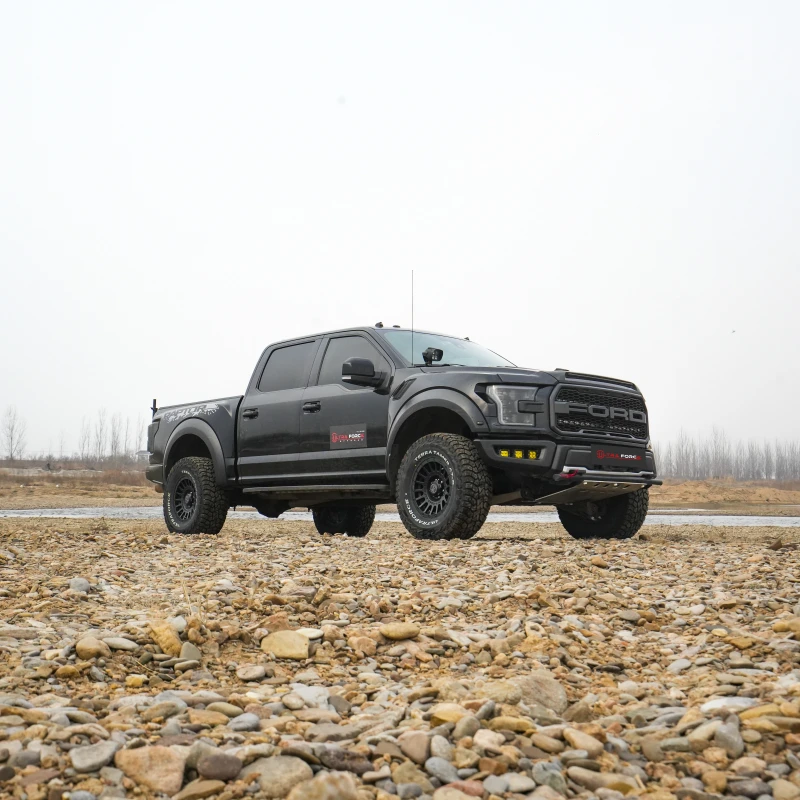
Mud Terrain Tires Perform in Wet Conditions
Mud terrain tires are built for extreme off-road conditions, but their performance in wet conditions on paved roads is an important consideration for those who use their vehicles in varied environments.
Tread Design and Water Evacuation
Mud terrain tires feature large, aggressive tread blocks with deep voids designed to grip loose surfaces like mud, sand, and rocks. While these features provide excellent traction off-road, they can lead to challenges on wet roads.
In wet conditions, tires need to effectively channel water away from the contact patch to maintain grip. Traditional highway tires achieve this with intricate siping and circumferential grooves that direct water away from the tire surface, reducing the risk of hydroplaning.
Mud terrain tires, however, lack these finely tuned water evacuation features. The large voids in the tread can disperse water to some extent, but the overall design is not optimized for wet road traction.
Data Insight: A test conducted by Consumer Reports found that mud terrain tires had a 20% higher likelihood of hydroplaning at highway speeds compared to all-season tires. The increased risk of hydroplaning is due to the reduced surface area in contact with the road and the tire’s inability to quickly channel water away.
Case Study: Wet Road Performance
Consider the case of a Jeep Wrangler owner who frequently drives in wet conditions on both highways and off-road trails. The vehicle is equipped with mud terrain tires to handle off-road excursions, but the driver noticed significant differences in performance when driving on wet highways.
Initial Observations:
Hydroplaning Risk: At speeds above 50 mph, the vehicle showed a tendency to hydroplane, particularly in heavy rain.
Braking Distance: The Jeep required longer distances to come to a complete stop on wet roads, raising safety concerns during sudden braking situations.
Cornering Stability: The vehicle experienced reduced stability when cornering on wet roads, with a noticeable decrease in traction compared to dry conditions.
Outcome: After encountering a near-miss incident due to hydroplaning, the driver opted to reduce highway speeds during wet conditions and increased following distance to allow for longer braking times. The driver also considered switching to all-terrain tires for better wet road performance.
Wet Condition Safety with Mud Terrain Tires
While mud terrain tires can handle occasional wet conditions, they are not ideal for frequent use on wet paved roads. The risk of hydroplaning, longer stopping distances, and reduced cornering stability are key concerns that drivers should be aware of.
Data Insight: According to the National Highway Traffic Safety Administration (NHTSA), wet pavement is a contributing factor in 75% of all weather-related vehicle crashes. Using tires that are not optimized for wet conditions increases the risk of accidents.
Improving Wet Road Performance
If you choose to use mud terrain tires despite frequent wet road driving, here are some strategies to enhance safety:
Speed Reduction: Lowering your driving speed can significantly reduce the risk of hydroplaning and improve overall tire grip on wet surfaces.
Increased Following Distance: Allow more space between your vehicle and others to accommodate longer stopping distances.
Tire Maintenance: Regularly inspect your tires for wear and ensure they are properly inflated. Worn treads or under-inflated tires exacerbate the risks in wet conditions.
Alternative Tire Choices: If wet road performance is a significant concern, consider switching to all-terrain (A/T) tires, which offer a balance between off-road capability and on-road safety, including better wet road traction.
In conclusion, while mud terrain tires can perform adequately in wet conditions under cautious driving, they are not the safest option for regular wet road use. Drivers should be aware of the limitations and take proactive measures to mitigate risks, or consider alternative tire options for better wet road safety.
How Long Do Mud Terrain Tires Last on Paved Roads?
Mud terrain (MT) tires are designed primarily for off-road use, with robust construction and aggressive tread patterns to handle extreme conditions. However, their durability on paved roads can vary significantly depending on several factors.
Understanding Tread Life and Wear
The lifespan of mud terrain tires on paved roads is influenced by the tire’s tread compound, driving habits, and road conditions. MT tires typically use harder rubber compounds and larger tread blocks, which are ideal for off-road durability but may wear faster on smooth, paved surfaces.
Data Insight: According to the Rubber Manufacturers Association, the average lifespan of a standard highway tire is around 50,000 to 60,000 miles. In contrast, mud terrain tires, when used predominantly on paved roads, may only last between 30,000 to 40,000 miles. This reduction in lifespan is due to the increased friction and heat generated on paved surfaces, which accelerates tread wear.
Case Study: Longevity Comparison
Consider a scenario involving a Ford F-150 owner who uses their truck for both daily commuting on highways and weekend off-roading adventures. The vehicle was initially equipped with all-terrain (A/T) tires, which were later replaced with mud terrain tires to improve off-road performance.
Pre-Switch (All-Terrain Tires):
Lifespan: Approximately 55,000 miles on mixed-use (70% highway, 30% off-road)
Tread Wear: Even wear with regular tire rotation
Post-Switch (Mud Terrain Tires):
Lifespan: Approximately 35,000 miles on mixed-use (70% highway, 30% off-road)
Tread Wear: Faster wear on the center tread blocks, particularly on paved roads
Outcome: The mud terrain tires wore out more quickly on paved roads compared to the all-terrain tires, requiring replacement after 35,000 miles. This accelerated wear was attributed to the increased friction and lack of highway optimization in the MT tires.
Maximizing Mud Terrain Tire Lifespan
While mud terrain tires are not specifically designed for long-term use on paved roads, there are strategies to extend their lifespan:
Regular Tire Rotation: Rotate the tires every 5,000 to 7,000 miles to ensure even tread wear, especially important for MT tires used on paved roads.
Proper Inflation: Keep the tires properly inflated according to the manufacturer’s recommendations. Under-inflation increases rolling resistance and accelerates tread wear, while over-inflation can cause uneven wear.
Moderate Driving Habits: Avoid aggressive driving behaviors such as rapid acceleration, hard braking, and high-speed cornering, which can increase tread wear on paved roads.
Data Insight: A study by the National Highway Traffic Safety Administration (NHTSA) found that proper tire maintenance, including regular inflation checks and rotation, can extend tire life by up to 20%. For mud terrain tires, this maintenance is crucial to achieving the maximum possible lifespan on paved roads.
Tire Selection Considerations
For drivers who spend a significant amount of time on paved roads but still require off-road capability, an all-terrain (A/T) tire may offer a better balance between durability and performance. A/T tires are designed to provide reasonable off-road capability while offering a longer lifespan on paved roads.
Alternative Option: Some manufacturers offer hybrid tires that blend the characteristics of all-terrain and mud terrain tires, offering more durability on paved roads without sacrificing too much off-road performance.
In conclusion, while mud terrain tires offer superior off-road capabilities, their lifespan on paved roads is typically shorter than that of all-terrain or highway tires. By following proper maintenance practices and considering driving habits, drivers can extend the life of their MT tires when used on paved roads.
How Noisy Are Mud Terrain Tires on Highways?
Mud terrain (MT) tires are known for their aggressive tread patterns, designed to provide maximum traction in off-road conditions. However, this design can lead to increased noise levels when driving on highways and other paved roads.
Noise Levels and Tread Design
The noise produced by tires, often referred to as road noise, is primarily influenced by the tread pattern. Mud terrain tires have large, widely spaced lugs and deep voids, which create a distinct and often loud noise when they make contact with paved surfaces. The large gaps between the tread blocks trap and release air as the tire rolls, resulting in a roaring or humming sound that can be more pronounced at higher speeds.
Data Insight: A study by Consumer Reports found that mud terrain tires can produce noise levels up to 10-15 decibels higher than standard highway tires. To put this in perspective, a 10-decibel increase is perceived by the human ear as roughly twice as loud, making the difference quite noticeable, especially during long highway drives.
Case Study: Highway Noise Experience
Consider the experience of a Chevrolet Silverado owner who regularly drives long distances on highways but also enjoys weekend off-roading. The vehicle was equipped with mud terrain tires to handle challenging off-road conditions, but the driver soon noticed a significant increase in noise during highway travel.
Initial Observations:
Noise Levels: At speeds above 60 mph, the driver reported a consistent, loud hum that made conversation difficult and required higher volumes for music and phone calls.
Vibration: In addition to the noise, the aggressive tread pattern caused minor vibrations that could be felt through the steering wheel, further contributing to driver fatigue during long trips.
Passenger Feedback: Passengers also remarked on the noise, particularly during extended highway drives, expressing discomfort due to the constant sound.
Outcome: The driver eventually decided to switch to a set of all-terrain tires for the highway seasons, while reserving the mud terrain tires for dedicated off-road use. This switch significantly reduced road noise, making highway travel more comfortable.
Reducing Highway Noise with Mud Terrain Tires
While mud terrain tires are inherently noisier on highways, there are a few strategies to minimize the impact:
Tire Maintenance: Keeping tires properly inflated and ensuring they are balanced can help reduce some of the noise and vibration. Uneven wear or improperly balanced tires can exacerbate noise levels.
Soundproofing: Adding sound-deadening materials to the vehicle's cabin, such as foam or mats, can help reduce the perception of road noise, making the ride more comfortable.
Speed Management: Driving at slightly lower speeds can reduce the noise generated by the tires, though this may not always be practical depending on the road conditions.
Data Insight: A report by the National Highway Traffic Safety Administration (NHTSA) highlights that tire noise increases exponentially with speed. For mud terrain tires, even a small reduction in speed can noticeably decrease the noise level inside the vehicle.
Alternative Tire Choices
For drivers who prioritize quietness on highways but still need off-road capability, all-terrain (A/T) tires may be a more suitable option. These tires offer a balance between off-road performance and on-road comfort, with less aggressive tread patterns that produce lower noise levels.
Hybrid Tires: Another option is hybrid tires that combine elements of both mud terrain and all-terrain designs. These tires aim to provide decent off-road traction while maintaining more acceptable noise levels on paved roads.
In conclusion, mud terrain tires are naturally noisier on highways due to their aggressive tread design. While this noise is a trade-off for their superior off-road performance, drivers can take steps to reduce its impact. For those who frequently drive on highways, considering an alternative tire design might be the best solution for a quieter and more comfortable ride.
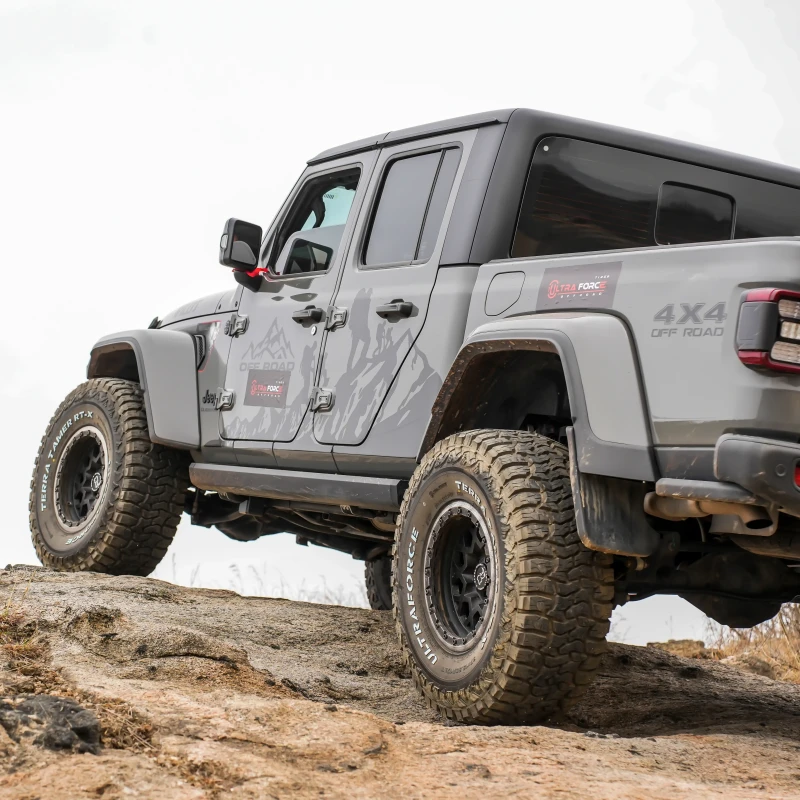
Can Mud Terrain Tires Be Used Year-Round?
Mud terrain (MT) tires are specialized for off-road use, but many drivers wonder if they can be used year-round for all driving conditions, including everyday commuting and seasonal changes.
Mud Terrain Tires in Various Conditions
Mud terrain tires are built with ruggedness in mind, featuring deep, aggressive treads that excel in off-road conditions like mud, rocks, and loose soil. However, their performance varies significantly depending on the driving environment and weather conditions.
Dry Pavement: On dry pavement, mud terrain tires perform adequately but are not as efficient as all-season or highway tires. The large tread blocks and deep voids can reduce contact with the road, leading to less traction and stability compared to tires designed for paved surfaces.
Wet Conditions: As discussed in previous FAQs, mud terrain tires are not optimized for wet conditions, particularly on paved roads. The risk of hydroplaning and reduced braking performance are concerns that drivers need to be aware of.
Winter Driving: Mud terrain tires are generally not suitable for icy or snowy conditions, as they lack the specialized rubber compounds and tread designs needed for winter traction. The stiff rubber used in MT tires can become even harder in cold temperatures, further reducing grip.
Data Insight: The Tire and Rubber Association of Canada notes that all-season tires (and by extension, mud terrain tires) start to lose their effectiveness below 7°C (45°F) due to the hardening of the rubber compound. This reduction in flexibility significantly impacts traction in winter conditions.
Case Study: Year-Round Use Experience
Consider a Jeep Wrangler owner who lives in an area with four distinct seasons, ranging from hot summers to cold, snowy winters. The vehicle was equipped with mud terrain tires year-round, and the owner shared their experience across different seasons.
Summer (Dry and Off-Road):
Performance: The tires performed excellently off-road and adequately on dry pavement. However, the owner noticed increased road noise and a slight decrease in fuel efficiency.
Fall (Wet Conditions):
Performance: The tires began to show limitations on wet roads, particularly during heavy rains. The owner had to drive more cautiously to avoid hydroplaning and longer braking distances.
Winter (Snow and Ice):
Performance: The mud terrain tires struggled in icy and snowy conditions. The lack of siping and appropriate rubber compound led to reduced traction, and the vehicle was prone to sliding, especially on ice-covered roads.
Outcome: After a year of using mud terrain tires year-round, the owner decided to switch to all-terrain tires for better overall performance across different seasons, while reserving the MT tires for off-road adventures only.
Considerations for Year-Round Use
While mud terrain tires can technically be used year-round, they are not the most practical choice for drivers who encounter diverse road conditions throughout the year. Here are some key considerations:
Seasonal Tire Rotation: For those committed to using mud terrain tires, consider rotating them with a set of all-season or winter tires depending on the season. This approach ensures optimal performance and safety throughout the year.
Driving Conditions: Assess the typical driving conditions you face. If you frequently drive on paved roads or in winter conditions, all-terrain or winter tires may offer better safety and comfort.
Data Insight: According to a study by the Canadian Automobile Association (CAA), vehicles equipped with winter tires have a 38% reduction in collisions compared to those with all-season tires in winter conditions. This data underscores the importance of using season-appropriate tires for optimal safety.
Tire Selection for Versatility
For drivers who want a tire that can handle a variety of conditions year-round, all-terrain (A/T) tires or hybrid tires may be a better choice. These tires offer a balance between on-road comfort, off-road capability, and seasonal versatility.
Hybrid Tires: Some tire manufacturers offer hybrid options that blend the durability of mud terrain tires with the versatility of all-terrain tires. These tires can be a good compromise for drivers who need off-road capability but also require better on-road and seasonal performance.
In conclusion, while mud terrain tires can be used year-round, they are not the ideal choice for all driving conditions. For those who encounter a variety of road and weather conditions, considering alternative tire options or rotating tires seasonally may provide better safety and performance.
Why Choose UltraForce Tires?
At UltraForce Tires, we understand that every driver’s needs are unique. That’s why we offer a diverse range of tires designed to excel in various driving conditions, from city streets to the most challenging off-road trails.
Performance and Durability: Our mud terrain tires are engineered to deliver superior traction and durability in the toughest off-road conditions. Whether you’re navigating rocky trails, deep mud, or loose sand, UltraForce Tires provide the confidence and control you need to conquer any terrain.
Customized Solutions: We offer customized services, including tread and sidewall design, size options, branding, and performance enhancements tailored to your specific driving conditions. Our goal is to help you get the most out of your vehicle, whether you’re exploring the wilderness or cruising the highway.
Global Expertise: With decades of experience in product development and global export, UltraForce Tires is a trusted name in the tire industry. Our commitment to excellence and customer satisfaction has made us a preferred choice for drivers worldwide.
Your Ultimate Driving Companion: At UltraForce Tires, we believe that you deserve the best driving experience, no matter where your journey takes you. Our tires are not only built to meet your daily driving needs but also stand as the ultimate companions for your off-road adventures. When you choose UltraForce Tires, you’re choosing performance, reliability, and a brand that puts you first.
Contact Us Today: Ready to upgrade your driving experience? Visit our website or contact us to learn more about our products and services. Let UltraForce Tires be your partner on the road and beyond.
